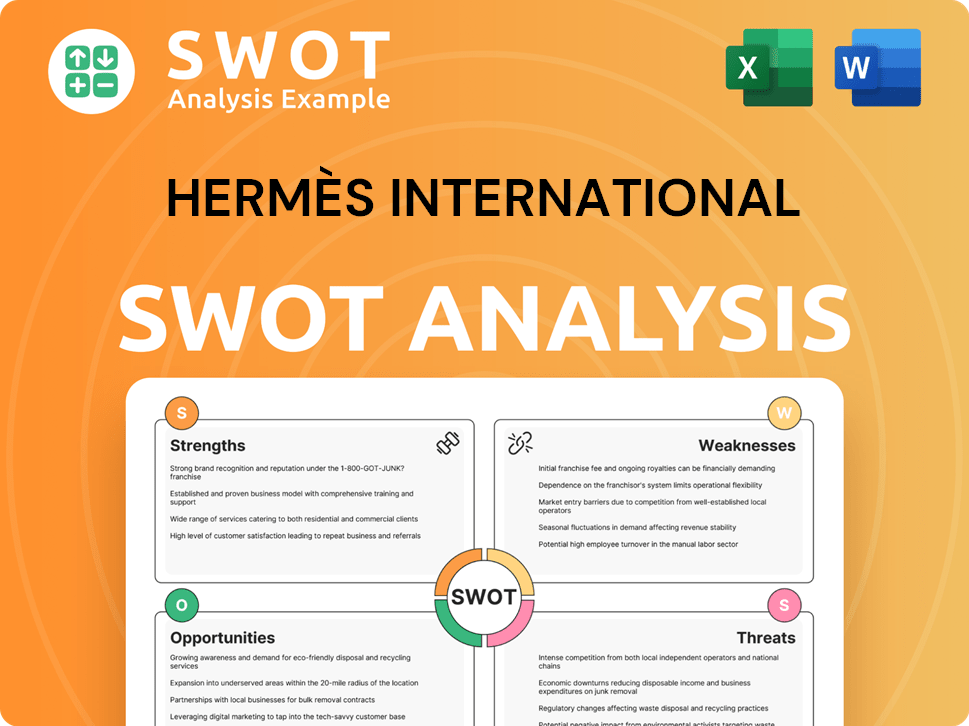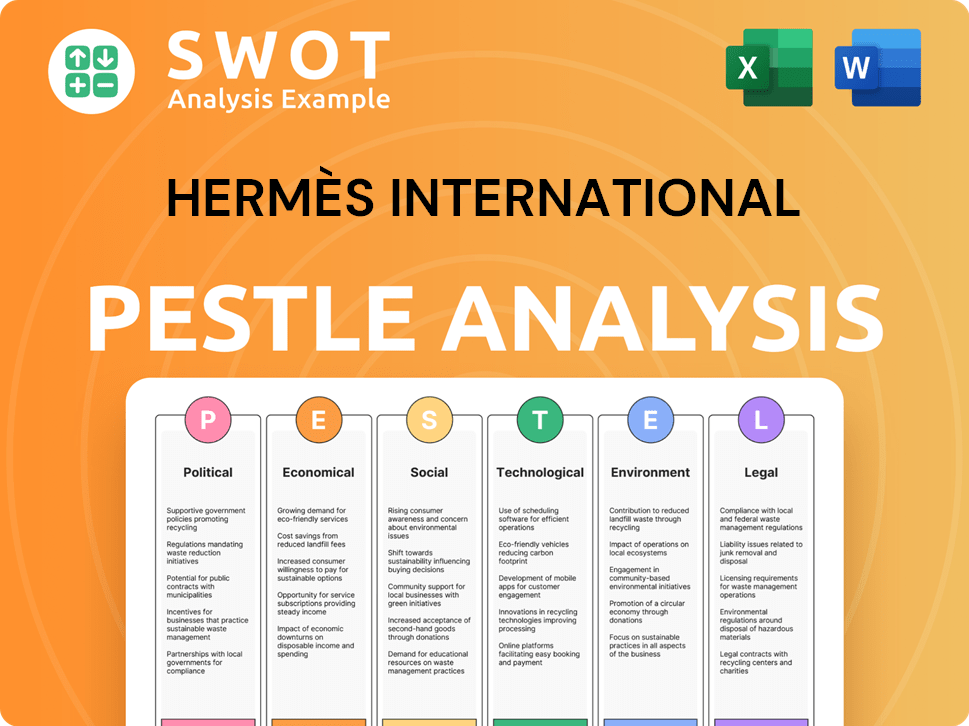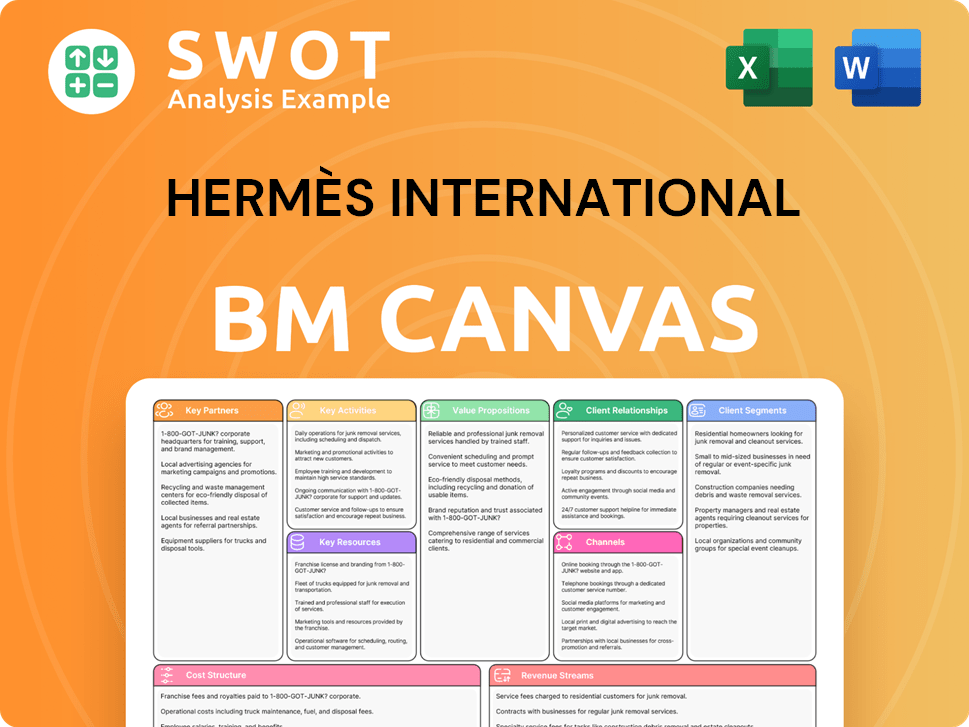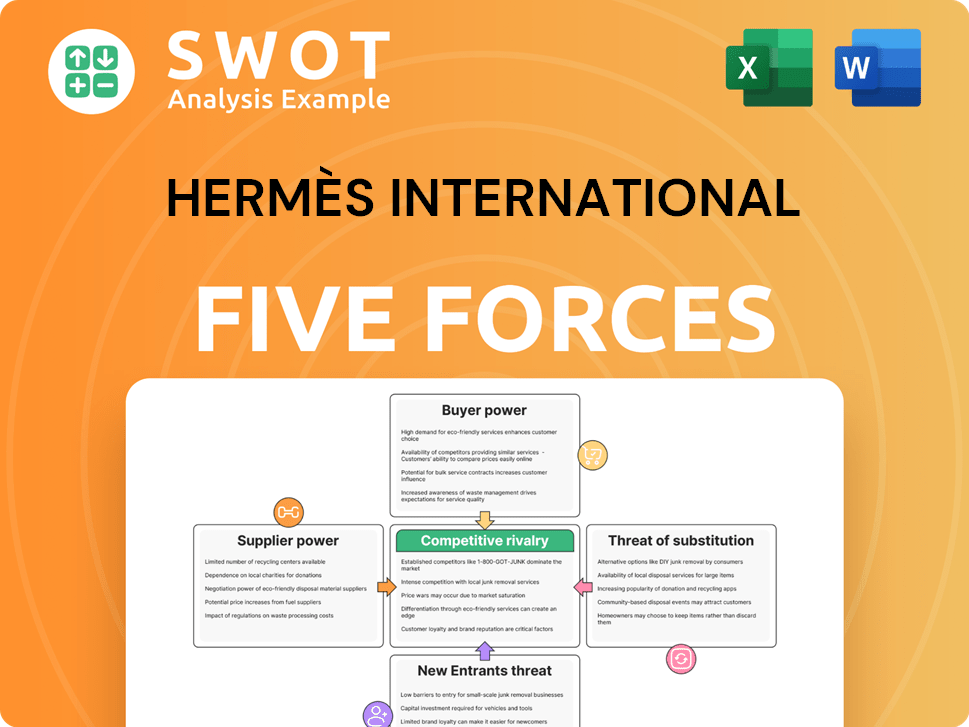Hermès International Bundle
How Does Hermès Maintain Its Allure?
From its origins as a Parisian saddlery to a global luxury powerhouse, Hermès has captivated the world with its exquisite craftsmanship and unwavering commitment to quality. This transformation, sparked by iconic products like the Birkin bag, showcases a masterful approach to brand building. Understanding the Hermès International SWOT Analysis is key to grasping its strategic prowess.

This document will explore the intricate Hermès sales strategy and marketing strategy, revealing how the brand cultivates desire and maintains its prestigious position. We'll dissect Hermès's unique approach to high-end fashion sales, examining its distribution channel optimization and customer acquisition strategies. By analyzing Hermès's brand positioning strategy and marketing campaign examples, we'll uncover the secrets behind its enduring success in the competitive luxury brand marketing landscape, including its digital marketing initiatives and global market expansion strategy.
How Does Hermès International Reach Its Customers?
The sales strategy of Hermès International, a luxury brand, centers on a carefully controlled distribution network. This approach is crucial for maintaining the brand's exclusive image. The company prioritizes direct-to-consumer (DTC) channels, ensuring a consistent, high-end retail experience globally.
Hermès's primary sales channels include directly operated stores and a limited number of authorized retailers. As of December 31, 2023, the company operated a network of 300 exclusive stores worldwide, with 224 directly managed. This strategy allows Hermès to cultivate direct relationships with its clientele.
The company has also strategically embraced e-commerce, recognizing the importance of digital channels in the luxury market. The official website serves as a key online sales platform. The performance of online channels has shown significant growth, contributing to the overall revenue increase. For example, in 2023, recurring operating income reached €5,652 million, up 20% compared to 2022, indicating the effectiveness of its omnichannel approach. If you're interested in understanding the competitive environment, consider exploring the Competitors Landscape of Hermès International.
The DTC model is central to Hermès's sales strategy. It allows the company to maintain control over the brand experience and customer relationships. This approach is critical for preserving the luxury brand's image and ensuring consistent quality.
Hermès has strategically integrated e-commerce into its sales channels, recognizing the growing importance of digital platforms. The official website offers a curated selection of products. Digital sales have contributed significantly to the overall revenue growth.
Key partnerships are highly selective, often limited to high-end department stores for specific product categories. This approach ensures alignment with the brand's luxury positioning. The focus remains on maintaining brand control and exclusivity.
Hermès continues to expand its physical footprint, particularly in key luxury markets like Asia. In 2023, the group completed eight store renovations and openings. These expansions support the brand's global growth strategy.
Hermès's sales strategy emphasizes direct control over distribution channels to maintain its luxury brand image. This involves a strong DTC model and selective partnerships. The company's approach has been a significant contributor to its sustained growth.
- Directly Operated Stores: A network of exclusive stores managed by Hermès.
- E-commerce: A curated online platform to complement physical stores.
- Strategic Partnerships: Selective collaborations with high-end retailers.
- Global Expansion: Continued investment in key luxury markets.
Hermès International SWOT Analysis
- Complete SWOT Breakdown
- Fully Customizable
- Editable in Excel & Word
- Professional Formatting
- Investor-Ready Format

What Marketing Tactics Does Hermès International Use?
The marketing tactics of Hermès International are carefully designed to maintain its exclusive brand image and engage with a discerning global audience. This approach blends digital and traditional methods, creating a cohesive strategy that emphasizes craftsmanship and heritage. The goal is to cultivate aspiration and appreciation for its products while ensuring a personalized customer experience.
Hermès focuses on storytelling and immersive experiences across both online and offline channels. The brand strategically uses content marketing to showcase its artisanal heritage, while also leveraging social media for visual storytelling. This approach helps to build brand loyalty and maintain a strong connection with its clientele.
Hermès's marketing strategy is a blend of digital and traditional tactics. The company uses its official website as a hub for brand storytelling and e-commerce. High-quality editorial features and behind-the-scenes glimpses into its craftsmanship are used to foster appreciation for its products. Social media platforms are used for visual storytelling, showcasing new collections and events.
Hermès's digital marketing strategy centers on its official website and social media platforms. The website serves as a central hub for brand storytelling and e-commerce. Social media platforms, like Instagram, are used for visual storytelling, showcasing new collections and engaging with the community.
Content marketing plays a significant role in Hermès's strategy. The brand uses high-quality editorial features and behind-the-scenes content. This approach fosters a sense of aspiration and appreciation for its products, reinforcing its brand positioning strategy.
Hermès uses social media platforms like Instagram for visual storytelling. This includes showcasing new collections, events, and engaging with its community. The brand maintains an understated approach to influencer partnerships, focusing on organic endorsements.
Traditionally, Hermès invests in exclusive events, fashion shows, and print media placements. These events are crucial for showcasing new collections and reinforcing the brand's prestige. The company's approach to data-driven marketing is subtle, focusing on personalized experiences.
Hermès uses data to understand the preferences of its elite clientele. This allows the brand to offer highly personalized experiences, both online and in-store. Customer segmentation is primarily based on purchase history and engagement.
The e-commerce strategy is integrated into the existing luxury framework. Hermès likely uses advanced CRM systems to manage customer relationships and track preferences. This ensures a consistent and elevated customer journey.
The company's marketing mix integrates digital channels seamlessly into its existing luxury framework. Hermès maintains a balance between accessibility and exclusivity. Notable innovations include the development of immersive digital experiences and virtual events, allowing the brand to connect with a wider audience while preserving its aura of exclusivity. For example, in 2023, Hermès reported a revenue increase of 21.4% at constant exchange rates, demonstrating the effectiveness of its sales strategy. The brand's focus on craftsmanship and heritage, combined with strategic marketing, has contributed to its strong performance in the luxury goods market. To learn more about the brand, you can read a Brief History of Hermès International.
Hermès's marketing strategy is built on several key elements that contribute to its success in the luxury market. These elements include a strong emphasis on brand storytelling, customer personalization, and a balance between digital and traditional marketing channels.
- Brand Storytelling: Hermès uses its website and content marketing to showcase its heritage and craftsmanship.
- Customer Personalization: The brand uses data to understand customer preferences and offer tailored experiences.
- Exclusive Events: Hermès invests in fashion shows and events to showcase new collections and reinforce its prestige.
- Digital Integration: Digital channels are seamlessly integrated into the existing luxury framework.
- E-commerce Strategy: The e-commerce strategy is designed to maintain exclusivity while reaching a wider audience.
Hermès International PESTLE Analysis
- Covers All 6 PESTLE Categories
- No Research Needed – Save Hours of Work
- Built by Experts, Trusted by Consultants
- Instant Download, Ready to Use
- 100% Editable, Fully Customizable

How Is Hermès International Positioned in the Market?
The brand positioning of Hermès International is meticulously crafted to reside at the apex of the luxury market. The company differentiates itself through exceptional craftsmanship, timeless elegance, and unwavering quality. This strategic positioning is not achieved through aggressive marketing campaigns, but through a steadfast commitment to artisanal excellence and controlled scarcity, which is a key element of their Growth Strategy of Hermès International.
Hermès' core message revolves around heritage, authenticity, and the enduring value of handcrafted objects. This appeals to a target audience that values understated luxury, exclusivity, and longevity over fleeting trends. The visual identity, with its iconic orange packaging and equestrian motifs, reinforces this sophisticated aesthetic. The brand's tone of voice is consistently refined, discreet, and authoritative, reflecting its commitment to a premium customer experience.
The customer experience promised by Hermès is one of unparalleled service and personalized attention, offering access to exclusive products and events. The unique selling proposition centers on true luxury, rooted in its rich history, the exceptional quality of its materials, and meticulous attention to detail. This approach allows Hermès to maintain its position in the luxury market, with a focus on enduring value and craftsmanship.
Hermès leverages its rich history and heritage to connect with consumers. The brand's legacy of craftsmanship and the enduring value of its pieces are central to its appeal. This focus on heritage allows Hermès to differentiate itself from competitors.
The brand's commitment to artisanal excellence is a key differentiator. Each product reflects meticulous attention to detail, enhancing its perceived value. This emphasis on craftsmanship supports Hermès' premium pricing strategy and brand image.
Hermès targets a discerning clientele that values understated luxury, exclusivity, and longevity. This audience appreciates the brand's commitment to quality and is willing to invest in products that offer enduring value. The brand's marketing efforts are precisely targeted to this demographic.
The visual identity of Hermès is characterized by its iconic orange packaging, equestrian motifs, and sophisticated aesthetic. These elements consistently reinforce the brand's image and contribute to its recognition. The visual elements are carefully maintained across all channels.
Hermès consistently ranks high in luxury brand indices, demonstrating strong brand equity. Its financial performance, such as a 20% increase in recurring operating income in 2023, reflects its formidable brand strength. The brand's value is consistently recognized by consumers.
Brand consistency is rigorously maintained across all channels. From physical boutiques to its online presence, Hermès ensures a cohesive and elevated brand experience. This consistency reinforces the brand's image and customer trust.
Hermès subtly integrates themes like responsible luxury without compromising its core values. The emphasis on durability and repairability aligns with eco-conscious values, appealing to a segment of discerning consumers. This approach enhances brand relevance.
The brand promises unparalleled service, personalized attention, and access to exclusive products and events. This focus on customer experience fosters brand loyalty and reinforces its premium positioning. This is a key component of Hermès' sales and marketing strategy.
Hermès' strong financial performance, including a 16% increase in revenue in 2023, underscores its successful brand positioning. This financial success is a direct result of its effective marketing and sales strategies. The brand is consistently growing.
Hermès' competitive advantage lies in its rich history, exceptional quality, and meticulous attention to detail. This allows the brand to maintain its premium pricing and attract a loyal customer base. This is a core element of its high-end fashion sales.
Hermès International Business Model Canvas
- Complete 9-Block Business Model Canvas
- Effortlessly Communicate Your Business Strategy
- Investor-Ready BMC Format
- 100% Editable and Customizable
- Clear and Structured Layout

What Are Hermès International’s Most Notable Campaigns?
The Hermès sales strategy and Hermès marketing strategy center on reinforcing its core values of craftsmanship, exclusivity, and artistic expression. Unlike many brands, it doesn't rely on mass-market campaigns. Instead, it focuses on strategic initiatives and product launches that reflect its commitment to luxury. This approach has been key to its enduring appeal within the high-end fashion sales market.
A prime example of this strategy is the Birkin bag. Its rise to legendary status wasn't through traditional marketing, but through word-of-mouth, celebrity association, and inherent scarcity. This approach created an iconic product that symbolizes the brand's ultimate luxury. This strategy has significantly boosted global recognition and sales of leather goods, demonstrating the power of exclusivity in the luxury brand marketing world.
More recently, Hermès' marketing efforts have emphasized thematic collections and artistic collaborations. These initiatives, such as the 'Astonishing Hermès' theme in 2023, permeate product design, window displays, and limited-edition collections. These themes are communicated through curated content on its website, social media, and exclusive events. These campaigns are crucial for maintaining brand relevance and engaging its sophisticated clientele.
The Birkin bag's success exemplifies Hermès' approach. It leveraged exclusivity and aspiration, resulting in high demand and waiting lists. This strategy has significantly contributed to the brand's global recognition and sales. This approach is a cornerstone of its Hermès brand positioning strategy.
Annual themes like 'Astonishing Hermès' in 2023 drive product design and limited-edition collections. These themes are communicated through various channels, maintaining brand relevance. These efforts are vital for engaging its sophisticated clientele and are a part of their Hermès customer acquisition strategies.
The 'Hermès in the Making' exhibition, touring in 2023 and 2024, showcased craftsmanship. This deepened brand appreciation and connected with consumers on an emotional level. This is a key component of their Hermès digital marketing initiatives.
Hermès often benefits from organic associations with high-profile individuals, enhancing its aspirational appeal. This approach supports its overall fashion retail strategy. The brand's success is rooted in consistent storytelling and unique experiences.
Hermès' Hermès International marketing strategy focuses on exclusivity and brand storytelling. This approach creates a strong connection with its target audience. For more insights into Hermès' financial performance, see this article on Hermès' financial strategy.
- Emphasis on craftsmanship and artistic expression.
- Use of thematic collections and collaborations.
- Experiential marketing to deepen brand appreciation.
- Organic celebrity associations to enhance appeal.
Hermès International Porter's Five Forces Analysis
- Covers All 5 Competitive Forces in Detail
- Structured for Consultants, Students, and Founders
- 100% Editable in Microsoft Word & Excel
- Instant Digital Download – Use Immediately
- Compatible with Mac & PC – Fully Unlocked

Related Blogs
- What are Mission Vision & Core Values of Hermès International Company?
- What is Competitive Landscape of Hermès International Company?
- What is Growth Strategy and Future Prospects of Hermès International Company?
- How Does Hermès International Company Work?
- What is Brief History of Hermès International Company?
- Who Owns Hermès International Company?
- What is Customer Demographics and Target Market of Hermès International Company?
Disclaimer
All information, articles, and product details provided on this website are for general informational and educational purposes only. We do not claim any ownership over, nor do we intend to infringe upon, any trademarks, copyrights, logos, brand names, or other intellectual property mentioned or depicted on this site. Such intellectual property remains the property of its respective owners, and any references here are made solely for identification or informational purposes, without implying any affiliation, endorsement, or partnership.
We make no representations or warranties, express or implied, regarding the accuracy, completeness, or suitability of any content or products presented. Nothing on this website should be construed as legal, tax, investment, financial, medical, or other professional advice. In addition, no part of this site—including articles or product references—constitutes a solicitation, recommendation, endorsement, advertisement, or offer to buy or sell any securities, franchises, or other financial instruments, particularly in jurisdictions where such activity would be unlawful.
All content is of a general nature and may not address the specific circumstances of any individual or entity. It is not a substitute for professional advice or services. Any actions you take based on the information provided here are strictly at your own risk. You accept full responsibility for any decisions or outcomes arising from your use of this website and agree to release us from any liability in connection with your use of, or reliance upon, the content or products found herein.